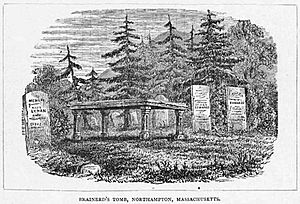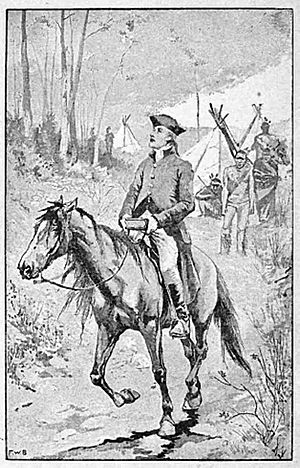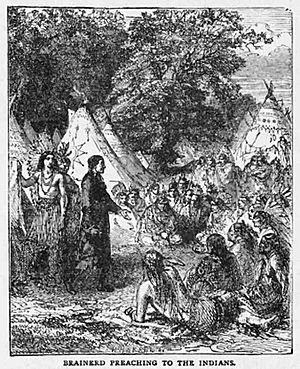David Brainerd facts for kids
Quick facts for kids David Brainerd |
|
|---|---|
 |
|
| Orders | |
| Ordination | 1744 |
| Personal details | |
| Born | 20 April 1718 Haddam, Connecticut Colony |
| Died | 9 October 1747 Northampton, Province of Massachusetts Bay |
| Nationality | American |
| Denomination | Presbyterian |
| Occupation | Minister, missionary |
David Brainerd (April 20, 1718 – October 9, 1747) was an American Presbyterian minister. He was also a missionary who worked with Native Americans, especially the Delaware Indians in New Jersey. Many famous missionaries, like William Carey and Jim Elliot, were inspired by David Brainerd's life and work.
Contents
Biography
Early life
David Brainerd was born on April 20, 1718, in Haddam, Connecticut. His father, Hezekiah, was a lawmaker in Connecticut. David had nine brothers and sisters. Sadly, he became an orphan at a young age. His father passed away in 1727 when David was nine, and his mother died five years later.
After his mother's death, David moved to East Haddam. He lived with one of his older sisters, Jerusha. When he was nineteen, he inherited a farm. But a year later, he returned to East Haddam to get ready for Yale. On July 12, 1739, he wrote about a powerful experience he had. He felt a strong desire to serve God. Many religious scholars believe this was a moment of deep spiritual change for him.
Preparing for his work
Two months later, David started at Yale. In his second year, he had to go home because he was very sick. He was spitting blood, which was a sign of tuberculosis. When he returned to Yale in November 1740, there were problems between the teachers and students. The teachers thought the students were too excited about their faith. This excitement came from visiting preachers like George Whitefield. Brainerd was later removed from Yale because of comments he made about the teachers.
At that time, a new law said that ministers in Connecticut had to graduate from Harvard, Yale, or a European school. This meant Brainerd had to change his plans. In 1742, a group of evangelicals called New Lights gave him permission to preach. This caught the attention of Jonathan Dickinson, a leading Presbyterian in New Jersey. Dickinson tried to get Brainerd back into Yale, but it didn't work.
Instead, Dickinson suggested that Brainerd become a missionary to Native Americans. The Society in Scotland for Propagating Christian Knowledge agreed to support him. Brainerd was approved for this missionary work on November 25, 1742.
Starting his mission
On April 1, 1743, David Brainerd began his work as a missionary to Native Americans. He continued this work until late 1746 when he became too sick to go on. During his time as a missionary, he also struggled with feeling sad, lonely, and often didn't have enough food.
His first mission was at Kaunameek. This was a Mohican settlement near what is now Nassau, New York. Brainerd stayed there for one year.
In 1743, he was sent to work among the Delaware Indians. They lived along the Delaware River in Pennsylvania. He stayed there for another year. During this time, he officially became a minister. After this, he moved to Crossweeksung in New Jersey. In just one year, the Native American church at Crossweeksung grew to 130 members. In 1746, they moved to Cranbury and created a Christian community there.
During these years, Brainerd was offered jobs to be a minister in regular churches many times. But he always chose to stay and work as a missionary.
Death
In November 1746, David became too ill to continue his work. He moved to Jonathan Dickinson's house in Elizabethtown. Later, he moved to Jonathan Edwards's house in Northampton, Massachusetts. He stayed there until he passed away the next year. In May 1747, doctors said he had an incurable illness, which was tuberculosis.
During this time, Jonathan Edwards's seventeen-year-old daughter, Jerusha Edwards, took care of him. They became good friends and later got engaged. David Brainerd died from tuberculosis on October 9, 1747, when he was only 29 years old. He is buried in the Bridge Street Cemetery in Northampton. Jerusha is buried next to him. She died in February 1748 after catching tuberculosis from caring for Brainerd.
After David's death, his younger brother, John Brainerd (1720–1781), continued his missionary work.
Legacy
Impact on the church and mission

David Brainerd didn't convert a huge number of people during his lifetime. However, he became very well known in the 1800s because of books written about him. His own Journal was published in 1746.
Most of Brainerd's influence came from a biography written by Jonathan Edwards. It was published in 1749 and called An Account of the Life of the Late Reverend Mr. David Brainerd. This book became very popular. Theologian John Wesley told everyone to read it. Missionaries from the 1700s onwards found great inspiration from this book.
Other famous missionaries who said Brainerd's story influenced them include Henry Martyn, William Carey, Jim Elliot, and Adoniram Judson.
Impact on higher education
David Brainerd's life also played a part in the founding of Princeton College and Dartmouth College. Princeton was started because Presbyterian groups in New York and New Jersey were unhappy with Yale. Brainerd's expulsion from Yale was a big reason why people like Jonathan Dickinson and Aaron Burr decided to create a new college. In fact, classes for Princeton began in Dickinson's house in May 1747, while Brainerd was recovering there.
Dartmouth College started from a school founded by Eleazar Wheelock in 1748. This school was for both Native Americans and colonists. Wheelock was inspired by Brainerd's example of educating Native Americans.
Students at Lafayette College created the Brainerd Evangelical Society. They based it on Brainerd's teachings. Their goal was to "promote Christian Missions and the Evangelization of the World." In 1902, they built a place called Brainerd Hall (now Hogg Hall) for their religious meetings and as a fun place for students.
Archival collections
The Presbyterian Historical Society in Philadelphia, Pennsylvania, has some of David Brainerd's papers. These include a letter from Brainerd and notes about his published works.
See also
- Moses Tunda Tatamy (ca. 1690–1760), the first Native American baptized by Brainerd.
- Brainerd Mission to the Cherokee Indians (1817–1838)



